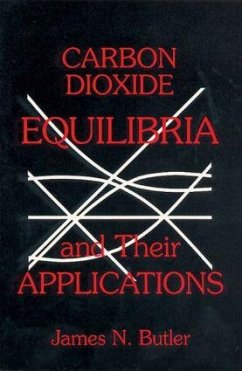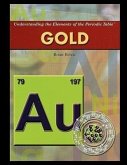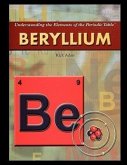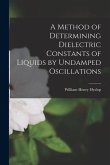James Newton Butler, Butler N. Butler, Butler James N.
Carbon Dioxide Equilibria and Their Applications
James Newton Butler, Butler N. Butler, Butler James N.
Carbon Dioxide Equilibria and Their Applications
- Broschiertes Buch
- Merkliste
- Auf die Merkliste
- Bewerten Bewerten
- Teilen
- Produkt teilen
- Produkterinnerung
- Produkterinnerung
Carbon dioxide, bicarbonate ion, and carbonate ion comprise the most important acid-base system in natural waters, and the equilibria between them regulate the pH of seawater, as well as most rainwater, stream water, river water, and groundwater
Andere Kunden interessierten sich auch für
![Gold Gold]() Brian BelvalGold35,99 €
Brian BelvalGold35,99 €![MAKING AND BREAKING SYMMETRY IN CHEMISTRY MAKING AND BREAKING SYMMETRY IN CHEMISTRY]() Michael J McglincheyMAKING AND BREAKING SYMMETRY IN CHEMISTRY84,99 €
Michael J McglincheyMAKING AND BREAKING SYMMETRY IN CHEMISTRY84,99 €![A Textbook of Inorganic Chemistry - Volume 1 A Textbook of Inorganic Chemistry - Volume 1]() Mandeep DalalA Textbook of Inorganic Chemistry - Volume 128,99 €
Mandeep DalalA Textbook of Inorganic Chemistry - Volume 128,99 €![A Manual of Inorganic Chemistry A Manual of Inorganic Chemistry]() Thomas Edward ThorpeA Manual of Inorganic Chemistry29,99 €
Thomas Edward ThorpeA Manual of Inorganic Chemistry29,99 €![Beryllium Beryllium]() Rick AdairBeryllium36,99 €
Rick AdairBeryllium36,99 €![Metal Ions in Biological Systems, Volume 43 - Biogeochemical Cycles of Elements Metal Ions in Biological Systems, Volume 43 - Biogeochemical Cycles of Elements]() Metal Ions in Biological Systems, Volume 43 - Biogeochemical Cycles of Elements94,99 €
Metal Ions in Biological Systems, Volume 43 - Biogeochemical Cycles of Elements94,99 €![A Method of Determining Dielectric Constants of Liquids by Undamped Oscillations A Method of Determining Dielectric Constants of Liquids by Undamped Oscillations]() William Henry HyslopA Method of Determining Dielectric Constants of Liquids by Undamped Oscillations17,99 €
William Henry HyslopA Method of Determining Dielectric Constants of Liquids by Undamped Oscillations17,99 €-
-
-
Carbon dioxide, bicarbonate ion, and carbonate ion comprise the most important acid-base system in natural waters, and the equilibria between them regulate the pH of seawater, as well as most rainwater, stream water, river water, and groundwater
Hinweis: Dieser Artikel kann nur an eine deutsche Lieferadresse ausgeliefert werden.
Hinweis: Dieser Artikel kann nur an eine deutsche Lieferadresse ausgeliefert werden.
Produktdetails
- Produktdetails
- Verlag: CRC Press / Routledge
- Seitenzahl: 272
- Erscheinungstermin: 7. Oktober 1991
- Englisch
- Abmessung: 234mm x 156mm x 15mm
- Gewicht: 418g
- ISBN-13: 9780873716246
- ISBN-10: 0873716248
- Artikelnr.: 23439720
- Herstellerkennzeichnung
- Libri GmbH
- Europaallee 1
- 36244 Bad Hersfeld
- gpsr@libri.de
- Verlag: CRC Press / Routledge
- Seitenzahl: 272
- Erscheinungstermin: 7. Oktober 1991
- Englisch
- Abmessung: 234mm x 156mm x 15mm
- Gewicht: 418g
- ISBN-13: 9780873716246
- ISBN-10: 0873716248
- Artikelnr.: 23439720
- Herstellerkennzeichnung
- Libri GmbH
- Europaallee 1
- 36244 Bad Hersfeld
- gpsr@libri.de
James N. Butler
REVIEW OF SOLUBILITY AND PH CALCULATIONS. Converting Chemical Models to
Mathematical Problems. Logarithmic and Exponential Functions. A Note on
Calculators. Strong Acids and Bases. Weak Acids. Titration with Strong
Base. Weak Bases. Polyprotic Acids. Buffers. Solubility Product. THE BASIC
EQUATIONS. Henry's Law. Hydration. Ionization. pH Dependence, Constant
Partial Pressure. The Charge Balance in the Presence of Base. Alkalinity.
Acidity. Solution without Gas Phase. Charge Balance and Proton Condition.
Relation between Alkalinity, pH, and CT. Acidity with Constant CT. A Note
on Concentration Units. Ionic-Strength Effects. The Davies Equation. Effect
of Ionic Strength on KH. Effect on Ionic Strength on First Acidity Constant
Ka1. Effect of Ionic Strength on Second Acidity Constant Ka2. Effect of
Ionic Strength on Ion Product of Water. Effect of Ionic Strength on
Solubility Product of CaCO3. THE ALKALINITY TITRATION CURVE. The Titration
Curve Equation. Titration Error. Effect of Ionic Strength. Total Alkalinity
and Carbonate Alkalinity. Linearized (Gran) Titration Curves. Linearizing
the Acid Portion of the Alkalinity Titration. Linearizing the HCO3 Region.
Other Linearized Portions of the Alkalinity Titration Curve. The CO3
Equivalence Point. Alkalinity Titration in Seawater. The Buffer Index.
Buffer Index at Constant CT. Buffer Index at Constant P. SOLUBILITY
EQUILIBRIA: CALCIUM CARBONATE. Calcium Carbonate, Carbon Dioxide, and
Water. Dolomite. Addition of Strong Base or Strong Acid at Constant P.
Limited Amount of CaCO3 in the Presence of Strong Acid. Solution without
Gas Phase. Addition of Strong Acid or Base in the Presence of CaCO3 without
Gas Phase. Limited Amount of CaCO3 at Constant CT. Buffer Index at Constant
P with CaCO3 Present. Buffer Index at Constant CT With CaCO3 Present.
Buffer Index with Constant D. APPLICATIONS TO GEOCHEMISTRY AND
OCEANOGRAPHY. Rainwater. Acid Rain. River Water. Unsaturated CaCO3 as a
Model for River and Groundwater. Saturated CO2, CaCO3, and H2O as a Model
for River and Groundwater. Other Components of River Water. Seawater.
Seawater as a Constant Ionic Strength Medium. Ion Pairing in Seawater.
Total Alkalinity and Carbonate Alkalinity in Seawater. Field Observations
of Seawater. The Lysocline. Effect of Increased Atmospheric CO2 on the
Oceans. Fresh Waters and Estuarine Waters. Brines. Hydrothermal Solutions.
ENGINEERING APPLICATIONS: WATER CONDITIONING. Estimation of Ionic Strength.
pH Adjustment by Addition of Acid or Base. Addition or Removal of CO2.
Addition of Lime. Addition of Limestone. The Langelier Index of CaCO3
Saturation. Corrosion Inhibition. The Lime-Soda Water Softening Process.
Stoichiometric Calculations. Formulation as an Equilibrium Problem.
Recarbonation. Chemical Coagulation and Flocculation. Removal of CO2 from
Process Gas. APPENDIXES. SUMMARY OF IMPORTANT RESULTS. The Basic Equations.
The Alkalinity Titration Curve. Solubility Equilibria: Calcium Carbonate.
Applications to Geochemistry and Oceanography. Engineering Applications:
Water Conditioning. USEFUL DATA TABLES. ANNOTATED BIBLIOGRAPHY. INDEX.
FEATURE:
Mathematical Problems. Logarithmic and Exponential Functions. A Note on
Calculators. Strong Acids and Bases. Weak Acids. Titration with Strong
Base. Weak Bases. Polyprotic Acids. Buffers. Solubility Product. THE BASIC
EQUATIONS. Henry's Law. Hydration. Ionization. pH Dependence, Constant
Partial Pressure. The Charge Balance in the Presence of Base. Alkalinity.
Acidity. Solution without Gas Phase. Charge Balance and Proton Condition.
Relation between Alkalinity, pH, and CT. Acidity with Constant CT. A Note
on Concentration Units. Ionic-Strength Effects. The Davies Equation. Effect
of Ionic Strength on KH. Effect on Ionic Strength on First Acidity Constant
Ka1. Effect of Ionic Strength on Second Acidity Constant Ka2. Effect of
Ionic Strength on Ion Product of Water. Effect of Ionic Strength on
Solubility Product of CaCO3. THE ALKALINITY TITRATION CURVE. The Titration
Curve Equation. Titration Error. Effect of Ionic Strength. Total Alkalinity
and Carbonate Alkalinity. Linearized (Gran) Titration Curves. Linearizing
the Acid Portion of the Alkalinity Titration. Linearizing the HCO3 Region.
Other Linearized Portions of the Alkalinity Titration Curve. The CO3
Equivalence Point. Alkalinity Titration in Seawater. The Buffer Index.
Buffer Index at Constant CT. Buffer Index at Constant P. SOLUBILITY
EQUILIBRIA: CALCIUM CARBONATE. Calcium Carbonate, Carbon Dioxide, and
Water. Dolomite. Addition of Strong Base or Strong Acid at Constant P.
Limited Amount of CaCO3 in the Presence of Strong Acid. Solution without
Gas Phase. Addition of Strong Acid or Base in the Presence of CaCO3 without
Gas Phase. Limited Amount of CaCO3 at Constant CT. Buffer Index at Constant
P with CaCO3 Present. Buffer Index at Constant CT With CaCO3 Present.
Buffer Index with Constant D. APPLICATIONS TO GEOCHEMISTRY AND
OCEANOGRAPHY. Rainwater. Acid Rain. River Water. Unsaturated CaCO3 as a
Model for River and Groundwater. Saturated CO2, CaCO3, and H2O as a Model
for River and Groundwater. Other Components of River Water. Seawater.
Seawater as a Constant Ionic Strength Medium. Ion Pairing in Seawater.
Total Alkalinity and Carbonate Alkalinity in Seawater. Field Observations
of Seawater. The Lysocline. Effect of Increased Atmospheric CO2 on the
Oceans. Fresh Waters and Estuarine Waters. Brines. Hydrothermal Solutions.
ENGINEERING APPLICATIONS: WATER CONDITIONING. Estimation of Ionic Strength.
pH Adjustment by Addition of Acid or Base. Addition or Removal of CO2.
Addition of Lime. Addition of Limestone. The Langelier Index of CaCO3
Saturation. Corrosion Inhibition. The Lime-Soda Water Softening Process.
Stoichiometric Calculations. Formulation as an Equilibrium Problem.
Recarbonation. Chemical Coagulation and Flocculation. Removal of CO2 from
Process Gas. APPENDIXES. SUMMARY OF IMPORTANT RESULTS. The Basic Equations.
The Alkalinity Titration Curve. Solubility Equilibria: Calcium Carbonate.
Applications to Geochemistry and Oceanography. Engineering Applications:
Water Conditioning. USEFUL DATA TABLES. ANNOTATED BIBLIOGRAPHY. INDEX.
FEATURE:
REVIEW OF SOLUBILITY AND PH CALCULATIONS. Converting Chemical Models to
Mathematical Problems. Logarithmic and Exponential Functions. A Note on
Calculators. Strong Acids and Bases. Weak Acids. Titration with Strong
Base. Weak Bases. Polyprotic Acids. Buffers. Solubility Product. THE BASIC
EQUATIONS. Henry's Law. Hydration. Ionization. pH Dependence, Constant
Partial Pressure. The Charge Balance in the Presence of Base. Alkalinity.
Acidity. Solution without Gas Phase. Charge Balance and Proton Condition.
Relation between Alkalinity, pH, and CT. Acidity with Constant CT. A Note
on Concentration Units. Ionic-Strength Effects. The Davies Equation. Effect
of Ionic Strength on KH. Effect on Ionic Strength on First Acidity Constant
Ka1. Effect of Ionic Strength on Second Acidity Constant Ka2. Effect of
Ionic Strength on Ion Product of Water. Effect of Ionic Strength on
Solubility Product of CaCO3. THE ALKALINITY TITRATION CURVE. The Titration
Curve Equation. Titration Error. Effect of Ionic Strength. Total Alkalinity
and Carbonate Alkalinity. Linearized (Gran) Titration Curves. Linearizing
the Acid Portion of the Alkalinity Titration. Linearizing the HCO3 Region.
Other Linearized Portions of the Alkalinity Titration Curve. The CO3
Equivalence Point. Alkalinity Titration in Seawater. The Buffer Index.
Buffer Index at Constant CT. Buffer Index at Constant P. SOLUBILITY
EQUILIBRIA: CALCIUM CARBONATE. Calcium Carbonate, Carbon Dioxide, and
Water. Dolomite. Addition of Strong Base or Strong Acid at Constant P.
Limited Amount of CaCO3 in the Presence of Strong Acid. Solution without
Gas Phase. Addition of Strong Acid or Base in the Presence of CaCO3 without
Gas Phase. Limited Amount of CaCO3 at Constant CT. Buffer Index at Constant
P with CaCO3 Present. Buffer Index at Constant CT With CaCO3 Present.
Buffer Index with Constant D. APPLICATIONS TO GEOCHEMISTRY AND
OCEANOGRAPHY. Rainwater. Acid Rain. River Water. Unsaturated CaCO3 as a
Model for River and Groundwater. Saturated CO2, CaCO3, and H2O as a Model
for River and Groundwater. Other Components of River Water. Seawater.
Seawater as a Constant Ionic Strength Medium. Ion Pairing in Seawater.
Total Alkalinity and Carbonate Alkalinity in Seawater. Field Observations
of Seawater. The Lysocline. Effect of Increased Atmospheric CO2 on the
Oceans. Fresh Waters and Estuarine Waters. Brines. Hydrothermal Solutions.
ENGINEERING APPLICATIONS: WATER CONDITIONING. Estimation of Ionic Strength.
pH Adjustment by Addition of Acid or Base. Addition or Removal of CO2.
Addition of Lime. Addition of Limestone. The Langelier Index of CaCO3
Saturation. Corrosion Inhibition. The Lime-Soda Water Softening Process.
Stoichiometric Calculations. Formulation as an Equilibrium Problem.
Recarbonation. Chemical Coagulation and Flocculation. Removal of CO2 from
Process Gas. APPENDIXES. SUMMARY OF IMPORTANT RESULTS. The Basic Equations.
The Alkalinity Titration Curve. Solubility Equilibria: Calcium Carbonate.
Applications to Geochemistry and Oceanography. Engineering Applications:
Water Conditioning. USEFUL DATA TABLES. ANNOTATED BIBLIOGRAPHY. INDEX.
FEATURE:
Mathematical Problems. Logarithmic and Exponential Functions. A Note on
Calculators. Strong Acids and Bases. Weak Acids. Titration with Strong
Base. Weak Bases. Polyprotic Acids. Buffers. Solubility Product. THE BASIC
EQUATIONS. Henry's Law. Hydration. Ionization. pH Dependence, Constant
Partial Pressure. The Charge Balance in the Presence of Base. Alkalinity.
Acidity. Solution without Gas Phase. Charge Balance and Proton Condition.
Relation between Alkalinity, pH, and CT. Acidity with Constant CT. A Note
on Concentration Units. Ionic-Strength Effects. The Davies Equation. Effect
of Ionic Strength on KH. Effect on Ionic Strength on First Acidity Constant
Ka1. Effect of Ionic Strength on Second Acidity Constant Ka2. Effect of
Ionic Strength on Ion Product of Water. Effect of Ionic Strength on
Solubility Product of CaCO3. THE ALKALINITY TITRATION CURVE. The Titration
Curve Equation. Titration Error. Effect of Ionic Strength. Total Alkalinity
and Carbonate Alkalinity. Linearized (Gran) Titration Curves. Linearizing
the Acid Portion of the Alkalinity Titration. Linearizing the HCO3 Region.
Other Linearized Portions of the Alkalinity Titration Curve. The CO3
Equivalence Point. Alkalinity Titration in Seawater. The Buffer Index.
Buffer Index at Constant CT. Buffer Index at Constant P. SOLUBILITY
EQUILIBRIA: CALCIUM CARBONATE. Calcium Carbonate, Carbon Dioxide, and
Water. Dolomite. Addition of Strong Base or Strong Acid at Constant P.
Limited Amount of CaCO3 in the Presence of Strong Acid. Solution without
Gas Phase. Addition of Strong Acid or Base in the Presence of CaCO3 without
Gas Phase. Limited Amount of CaCO3 at Constant CT. Buffer Index at Constant
P with CaCO3 Present. Buffer Index at Constant CT With CaCO3 Present.
Buffer Index with Constant D. APPLICATIONS TO GEOCHEMISTRY AND
OCEANOGRAPHY. Rainwater. Acid Rain. River Water. Unsaturated CaCO3 as a
Model for River and Groundwater. Saturated CO2, CaCO3, and H2O as a Model
for River and Groundwater. Other Components of River Water. Seawater.
Seawater as a Constant Ionic Strength Medium. Ion Pairing in Seawater.
Total Alkalinity and Carbonate Alkalinity in Seawater. Field Observations
of Seawater. The Lysocline. Effect of Increased Atmospheric CO2 on the
Oceans. Fresh Waters and Estuarine Waters. Brines. Hydrothermal Solutions.
ENGINEERING APPLICATIONS: WATER CONDITIONING. Estimation of Ionic Strength.
pH Adjustment by Addition of Acid or Base. Addition or Removal of CO2.
Addition of Lime. Addition of Limestone. The Langelier Index of CaCO3
Saturation. Corrosion Inhibition. The Lime-Soda Water Softening Process.
Stoichiometric Calculations. Formulation as an Equilibrium Problem.
Recarbonation. Chemical Coagulation and Flocculation. Removal of CO2 from
Process Gas. APPENDIXES. SUMMARY OF IMPORTANT RESULTS. The Basic Equations.
The Alkalinity Titration Curve. Solubility Equilibria: Calcium Carbonate.
Applications to Geochemistry and Oceanography. Engineering Applications:
Water Conditioning. USEFUL DATA TABLES. ANNOTATED BIBLIOGRAPHY. INDEX.
FEATURE:








